|
During World War II the former Lower Falls Civilian Conservation Camp was converted to a prisoner of war camp to house captured German soldiers. Not much is known of the Camp, though there are still area people who remember seeing the German POWs supplying scarce manpower to area farms and local canning factories. After the War the soldiers returned to Germany and eventually the Camp was taken down. See our Glimpse of the POW Camp for more information! Recently an artifact came to light from the POW Camp era. It appears that a local man, Archie Maker of Dalton NY, found a booklet and a letter in the old barracks shortly after the War. The original owner of the letter is only identified as "Arnfried" . We do know that he was a young man far from home who had a letter from his Mother while being held at the Park. Today these "Pieces of the Past" serve as reminders of an important episode in Letchworth Park's history. |
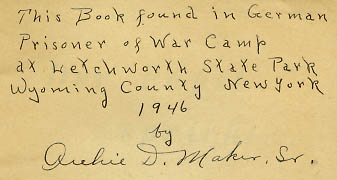 The title of the pamphlet
is "The Pope Speaks" and contains a variety of writings
focusing on peace and freedom. It is not known if the POW was
given the book at the Camp - it is possible that one of the Catholic
Churches in nearby Buffalo issued them to the prisoners. The title of the pamphlet
is "The Pope Speaks" and contains a variety of writings
focusing on peace and freedom. It is not known if the POW was
given the book at the Camp - it is possible that one of the Catholic
Churches in nearby Buffalo issued them to the prisoners. |
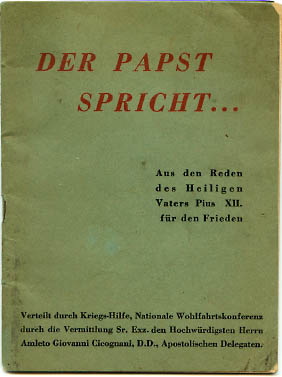 |
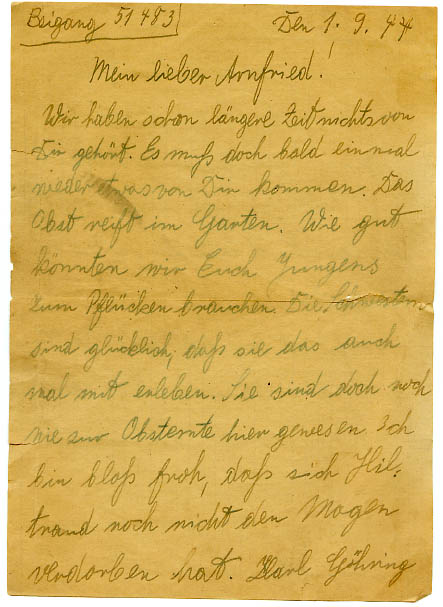 |
Here is a translation of the letter done by Soeren Melskotte, a German exchange student in my American History Class. We are grateful to Soeren for his work in translating and explaining the letter. Soeren tried to keep as close to the original wording as possible. Some additional notes are found at the bottom of the web page. "Bywalk 51483 The 1.9.44 (Sept 1, 1944) My Dear Arnfried! We haven't heard anything from you, for a longer (period of ) time. Something from you has to come some time. The fruits in the garden are ripening. How well, could we use you boys to pick the fruit. Your sisters are happy, that they can experience this for some time. They have never been here for the fruit harvest. I am just happy that Hiltraud hasn't upset her stomach yet. Karl Gohning is still on vacation. Wolfgang comes Sunday, he will be a Night Hunter. Eberhard is still at the harvest-help. Walter is for training at the RAD. Unfortunately I haven't heard anything from Dad. I have written you several times already, that he is missing since 8.6 (June 8th). I hope, that he has come in American captivity. Stay healthy and think about the future. Warmest greetings from your Mother, Grandmother in Hindern." |
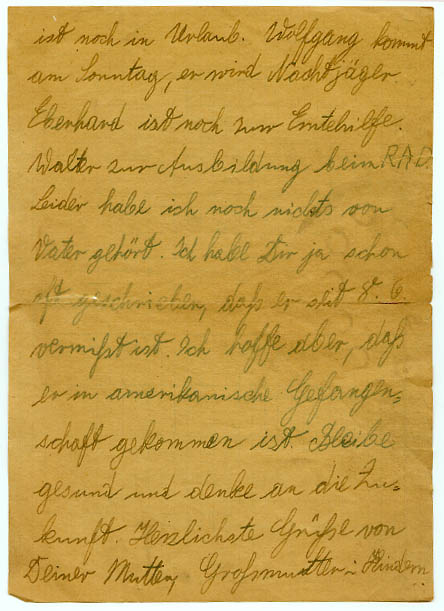 |
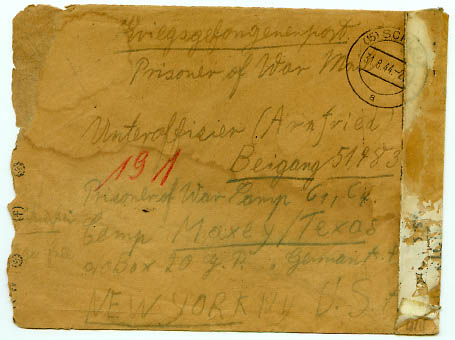 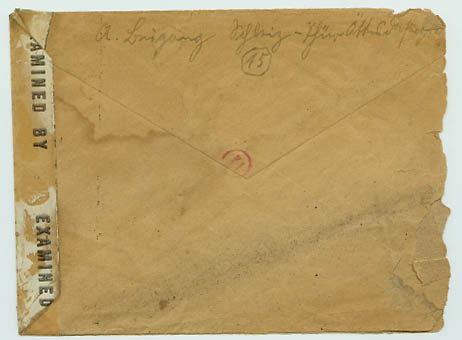 |
|
Some additional notes on the letter: Soeren did some additional research on some of the factual information provided in the letter. Wolfgang was a "Night Hunter" which probably means he flew the Ju 88R-1, a German fighter plane equipped with camouflage coating, special coverings to hid ethe flames of the engine exhausts, and a radar system. Walter was "training in the RAD". The RAD was the German National Work Service which started a year after the American CCC program. The RAD provided work for the unemployed, labor for local government projects, and what one sources describes as "pre-military training and indoctrination". All German males had to enter the Reich Arbeits Dienst (RAD) when they finished high school. It is likely that Arnfried was aware that he was held in an old CCC camp, a program that was, in some ways, similar to the RAD program that Arnfried had once been a part of. (Soeren recommends viewing the photographs of the Night Hunter and the RAD program found on Wikipedia) Also note that Arnfried's father had not been heard of since June 8th. That was two days after D-Day? Was he a defender at Normandy? His family had hoped that he had been captured by the Americans, so it may be that he had been stationed in France or perhaps Italy. You will also see a Texas address on the envelope. Perhaps Arnfried and others were transferred to an East coast camp near the end of the War. If a visitor has memories of the camp, German POW's at Letchworth, or additional information on the story of German prisoners held in the United States, please send it along. Special thanks to Soeren Melskotte for his help! We recently received additional information on these "pieces of the past" from Harry M. DeBan, Publications Director of Old Fort Niagara in Youngstown N.Y. Mr DeBan writes: "I do believe that I can help fill-in or clarify a few things regarding the envelope and letter found in 1946.... OK, the guy's name is Arnfried Beigang, with Beigang being his last name. There is no doubt. "Beigang" is underlined on the front of the envelope and the sender's surname on the back is also Beigang. The word may literally translate to "Bywalk," but Beigang is the Arnfried's last name. The
Texas address thing: Some of the first Axis POWs came to Fort
Niagara, from Texas (and then, for some, eventually on to the
satellite camps). Others came via the east coast. They all went
from here, at repatriation time, to the east coast, not to Texas.
There is a good possibility that what happened in this case is
that his family had an initial contact address for the camp in
Texas, and didn't have the new mailing one for up here yet. The
opening sentence of the letter indicates some time since Arnfried
had been heard from back home, so it is very likely that is the
reason for the Texas address. Also, since we don't know when
he was transferred up north here, he The dates: Interesting that the letter is dated September 1st, but the envelope is postmarked August 31st. Perhaps the German postal cancellation stamp wasn't changed yet for the next day, or the writer simply got the date wrong. Also,
on the envelope...on the back, where the sender's address is,
there is a "15" in a circle. That is the two digit
German postal code of the time for the area of Thüringen
(Thuringia). Because I cannot make out the full name of the posted
city on the front, I can't say what town/city it was mailed from.
The Berlin area was "1." There were 24 "area"
codes for the country and some occupied territory, with subsets
(e.g. 5a, 5b) as designated. This system was first put into effect
in July of 1941, to deal, primarily, with parcels. It was formalized,
nationwide, in 1943 for all mailings (except for About the Catholic book cover...again, you may already know this, but here goes anyway. The bottom translates to, basically: Distributed
Through War-Relief, National Welfare Conference War-Relief,
was the term referring to the "War Relief Services"
arm of the The
German abbreviations "Sr. Exz" are, literally, "Seiner
Exzellenz," in English, "Your Excellence." The
current Pope, when he was Cardinal, and writing in German to
a Bishop often used the salutation (with the exclamation marks):
Seiner Excellenz! The
full title used on the cover is a bit odd to translate literally
because the word "Hochwürdigsten" can take several
English forms, depending on the person, but it becomes, in English,
"The Most Reverend" or "The Most Worthy."
The "Most Worthy" understanding would most likely have
been the meaning taken by a German Catholic reader. The word
"Excellence" was/is usually used in Germany only when
the title has been formally conferred by the government (or a
government, or as in this case, the Vatican). However,"Your
Excellence" or "His Excellence" is common formal
diplomatic form everywhere, even today when talking about an
official government representative, as well as heads of state.
Amleto Giovanni Cicognani was a Bishop (with a Doctoral in Divinity,
of course) who held the honorific of "Archbishop,"
so the "Most Reverend" title is appropriate and proper
for a Bishop, in English, but the understanding of "Most
Worthy" also could be applied, since he was the Apostolic
Delegate. Cicognani was the Apostolic Delegate to the United
States from about 1933-1958, and he died in 1973 at the age of
90 (Feb. 24, 1883 to Dec. 17, 1973). He was elevated to the honor
I don't know what year it was produced in, but I am curious.
In 1943, the
As to whether Arn was given the booklet free of charge by
the Diocese of Buffalo, or whether it was obtained at the POW
Canteen, or Camp Library (if they had one there) is sheer speculation.
If it were from a camp library there should be a stamp to that
effect in it. The POW Canteen at Niagara sold a number of books
and booklets to the internees. By the way, Canteens were required
under the Geneva Convention of 1929 (which applied at the time).
Anyway, The works (books/booklets; many in German, some in English;
covered a wide range of topics and authors, including Germans)
were carefully picked and screened, obviously, but they were
purchased. One of the guys here spent much of the money he made
(and put into his camp account) buying books. All books sold
here at Niagara bore a three line stamp, usually on the title
page (in caps and flush left), which read: I don't know if the same stamp was used for anything that may have been available at the satellite camps, and I don't know how items were made available at them if there was no regular canteen, per say, at the smaller sites, but everybody who worked was paid (and the accounts were kept accurately), and access to canteen items was provided to everyone. In any event, Fort Niagara was the central provider for every location under its umbrella (hence the plural "PW CANTEENS" in the stamp). If there is no stamp inside the booklet you have there, then chances are it was given to him free of charge through the church. It could have been given to him by another POW who got it for free, or even from a guard or individual US civilian, but those last two are highly unlikely. Now, there's no way to know if he was Catholic, but if he wasn't, he probably accepted it simply because it was in German, and offered to him. Why
a POW would leave things like a letter or book behind is anybody's
guess. Maybe he had squirreled them away, and wasn't able to
retrieve before he was moved on, or maybe he just forgot them
(unlikely). Maybe he wasn't Catholic or cared less about the
Pope's commentaries about Peace, which might also be a reason
for leaving the book behind, but to have left a letter from home,
well, that's a really odd thing to do intentionally. It would
be interesting to find out if he is still alive, or what happened
to him after he left for repatriation.
|